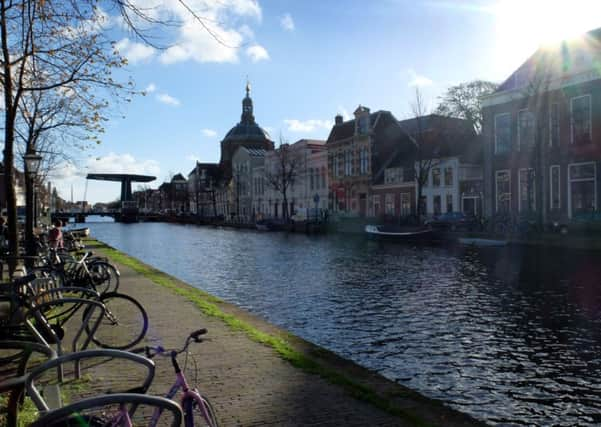Hidden Holland


Holland: known for clogs (hardly ever seen on feet and relegated to shiny tourist buys), English-speaking natives, cheese (hard to avoid), Amsterdam (almost too busy), cyclists (best avoided), tulips (not a Dutch native plant), windmills (only one in 100 left), and so on, but the best bit I have found is the city of Leiden.
A shrunk Amsterdam, easier to navigate, with a prosperous feel, well-kept houses, most of them magnificent, lining the many canals which are wide enough to manage dormant rows of house boats and leisure craft.
Advertisement
Hide AdAdvertisement
Hide AdStraddling the Rhine river, a must-see is the Hortus botanical gardens and greenhouses, a miniature Kew Gardens but no less important, holding unique specimens. There are plant fossils from an unnamed site in North Yorkshire, too, and an observatory where the mysteries of what’s out there are explained.
One of the most noticeable landmarks is the working windmill, Molen de Valk, or the Falcon Mill. For the national holiday on King’s Day it was wrapped in red, white and blue, the Dutch flag colours. In the streets almost everyone showed a splash of orange.
Holland once had 10,000 wind-driven mills, but in the 19th century the arrival of steam power made them uncompetitive. The Leiden mill had made flour from 1743 until it closed 90 years ago. Now restored, it’s worth a visit for the views from its upper platform and for the history and technique of milling as you progress through the seven floors up steep ladder stairs from the mill-owner’s living quarters.
Once you have exhausted Leiden’s impressive cultural and scientific heritage then the town is well-placed for easy transfer by road or rail to the Hague, the coast, and Amsterdam where the Van Gogh museum is on everyone’s list. The modern building displays his transition, in just 10 years, from beginner, through the moody dark oils of peasant life in northern hovel and field to the radiant whorls and slashes of colour in the sun, in the five years before his death in 1890. To avoid what can be long queues book online and enter by fast-track. (www.vangoghmuseum.nl).
Advertisement
Hide AdAdvertisement
Hide AdHave a look too at the Stedelijk Museum of modern art and the world-famous Rijksmuseum. All three are in the Museum Square (Museumplein), some 3km from the central station.
Cycle west 6km from Leiden and you reach Katwijk on the coast. In the dunes the River Rhine flows into the brown North Sea through a controlled sluice. The Dutch forever live under the threat of the sea and at Katwijk have raised a barrier of sand and stone to protect the town. It means that the cafes on the promenade no longer get a sea view – but at least they have extra protection from abnormally high tides.
Cafes still exist on the beach itself, single storey with large windows and waiter service to the tables and loungers outside. At one such cafe bar, PAAL 14, you can stay on the beach in self-catering chalets, only a few hundred yards back from the lapping waves.
“Wish it dream it, do it, is niet voor niets ons motto!” says the Dutch language brochure. Hmm why not? Rates start at 425 euros for the weekend, or from 400 euros Monday to Friday. No luck. Fully booked for the next five months when I enquired.
Advertisement
Hide AdAdvertisement
Hide AdResorts like Katwijk are familiar up this coast from northern France, through Belgium and into Holland. Cycling north to Noordwijk am Zee through the dunes was a quiet delight before being greeted by a harsh breeze off the sea.
In the coastal town of Scheveningen with its typical Dutch locked-in harbour, there was the usual toing and froing of yacht people. A woman in red trousers and red peaked cap rushed around taking photographs.
Later, to the Hague at night for ice cream at Florencia. This civilised “24 hour” life has never caught on in the UK despite similar climates. Even so, the police were cleaning up after a stabbing. Then a midnight walk through the courtyard of the Parliament.
Oh, and a word on cycling in Holland. Be alert for cyclists exercising their priority routes – indicated by white triangles on the paths and roads. The point facing you means give way. The riders, of all ages, push along at a brisk rate. Cycle tracks are shared with scooters limited to 25mph. If there is a track you are expected to use it. Stray on to the road proper and you’ll get peeped.
Advertisement
Hide AdAdvertisement
Hide Ad• When to go: April and early May for the arrays of tulip fields (subject to seasonal changes). Late April for the annual Koningsdag (King’s Day) which is a national holiday with street festivals and lots of orange garb. Check dates: they vary. May 5 celebrates the end of German occupation in 1945. October 3 when Leiden has fun, marking the end of a siege by the Spanish in 1574.
Getting there: Leiden is 43 miles from Rotterdam’s Europort, which takes at least an hour by road, including several miles along an estuary. En route are the Hague and Delft. P&O’s overnight sailing to and from Hull is the best link from the Yorkshire region. Prices start at £149 each way (stays over five days) for a car, two occupants and a cabin. www.poferries.com